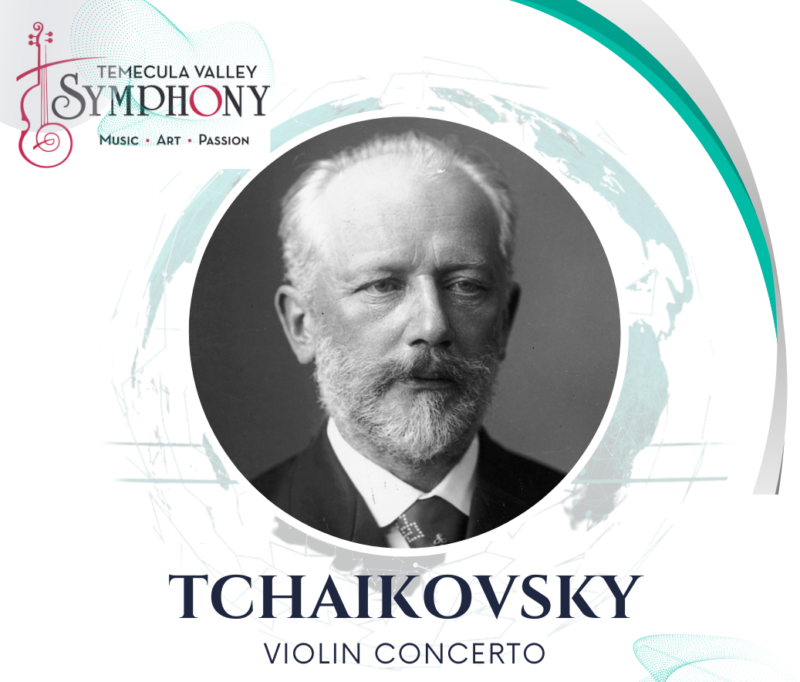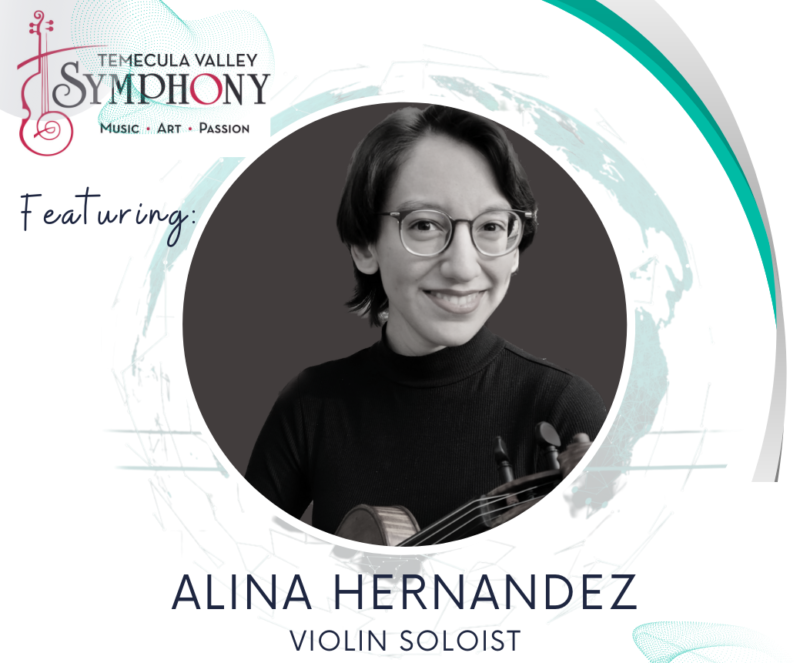This concert is dedicated to the memory of Jami Beck.
Brahms, Mozart, Shostakovich, and Tchaikovsky
Concert Program
Overture to Don Giovanni by Wolfgang Amadeus Mozart (1756-1791)
Violin Concerto in D Major, Opus 35 by Pytor Illyich Tchaikovsky (1840-1893)
I. Allegro Moderato – Moderato assai
Alina Hernandez, Violin
Cello Concerto, No. 1 in Eb Major, Opus 107 by Dimitri Shostakovich (1906-1975)
III. Cadenza
IV. Allegro Con Moto
Ruslan Biryukov, Cello
Intermission
Symphony No. 1 in C Minor, Opus 68 by Johannes Brahms (1833-1897)
I. Un Poco Sostenuto – Allegro
II. Andante sostenuto
III. Un Poco Allegretto e Grazioso
IV. Adagio – Più Allegro – Allegro non troppo, ma con brio – Più Allegro
Overture to Don Giovanni by Wolfgang Amadeus Mozart (1756-1791)
Violin Concerto in D Major, Opus 35 by Pytor Illyich Tchaikovsky (1840-1893)
I. Allegro Moderato – Moderato assai
Alina Hernandez, Violin
Cello Concerto, No. 1 in Eb Major, Opus 107 by Dimitri Shostakovich (1906-1975)
III. Cadenza
IV. Allegro Con Moto
Ruslan Biryukov, Cello
Intermission
Symphony No. 1 in C Minor, Opus 68 by Johannes Brahms (1833-1897)
I. Un Poco Sostenuto – Allegro
II. Andante sostenuto
III. Un Poco Allegretto e Grazioso
IV. Adagio – Più Allegro – Allegro non troppo, ma con brio – Più Allegro
Program Notes
We thank Kate Morics for her hard work in advance for writing these notes which are coming soon!
Mozart – Don Giovanni Overture
 The opera Don Giovanni (1787) is widely regarded as one of Wolfgang Amadeus Mozart’s (1756-1791) greatest works. The opera is set to an Italian libretto by Lorenzo la Ponte, which focuses on the established literary character Don Juan, a Spanish nobleman known for promiscuity and lascivious behavior. Throughout the opera, the title character engages in numerous acts of deceit in the name of seducing seemingly every woman he comes across. In the first act, Don Giovanni defeats the father of one of these women in a duel. In the opera’s conclusion, the defeated man returns as a reanimated statue, interrupting Don Giovanni’s lavish banquet and calling on him to repent for his sins. When Don Giovanni refuses to repent, he is pulled down into the flames of hell.
The opera Don Giovanni (1787) is widely regarded as one of Wolfgang Amadeus Mozart’s (1756-1791) greatest works. The opera is set to an Italian libretto by Lorenzo la Ponte, which focuses on the established literary character Don Juan, a Spanish nobleman known for promiscuity and lascivious behavior. Throughout the opera, the title character engages in numerous acts of deceit in the name of seducing seemingly every woman he comes across. In the first act, Don Giovanni defeats the father of one of these women in a duel. In the opera’s conclusion, the defeated man returns as a reanimated statue, interrupting Don Giovanni’s lavish banquet and calling on him to repent for his sins. When Don Giovanni refuses to repent, he is pulled down into the flames of hell.
The opera’s overture, which you will hear performed today, can be heard as following the plot of the opera in reverse. The overture begins in D minor, with rumbling chords and funeral march rhythms woven throughout, evoking the fate that befalls the title character at the end of the opera. This ominous opening eventually gives way to a playful dance for the entire orchestra in D major, embodying the playful comedy that characterizes the bulk of the opera’s plot. The tension between the opera’s comedic mood and its dramatic conclusion is part of what has drawn the attention of audiences, critics, and philosophers to Don Giovanni since its premiere.
Shostakovich – Cello Concerto, No. 1

Dmitri Shostakovich (1906-1975) is one of the most celebrated composers of the twentieth century, known for his ability to blend classical and traditional musical forms with more modern and unconventional tonalities. Much scholarly attention has been paid to Shostakovich’s relationship to the Soviet government. Shostakovich and his works were, at various points, denounced by the Soviet government for not conforming to the nationalist aesthetic ideals espoused by the Party. By 1959, however, Shostakovich had mostly returned to favor, and his Cello Concerto No. 1 in Eb Major (1959) was written just one year before the composer would officially join the Communist Party.
The concerto was written for and premiered by Shostakovich’s friend Mstislav Rostropovich, one of the twentieth century’s most esteemed cellists. It is often described as one of the most difficult pieces in the instrument’s repertoire due to the demands it places on both the instrument and performer. The third movement is a composed cadenza for the solo cello, although it also functions as a bridge between the first two movements and the piece’s conclusion. The cello expands on themes introduced in the second movement, interpreted with pizzicato chords, before beginning an increasingly agitated section that makes heavy use of the four-note motif introduced in the first movement. Comparisons have been drawn between this motif and the famous DSCH (D, E-flat, C, B-natural) motif based on his own name that Shostakovich would often place in his later works as a musical signature – although the motif present in this piece is composed of different tones. There is no pause before the fourth movement, in which the solo cello and orchestra trade new melodic themes back and forth before returning to first movement’s four-note motif. The movement surges forward from here, propelled by dazzling scale passages in the solo cello, dashing towards the piece’s conclusion.
Tchaikovsky – Violin Concerto

Russian composer Pyotr Illyich Tchaikovsky (1840-1893) wrote his Violin Concerto in D Major (1878) while in Switzerland, where he had retreated to recover from a deep depression brought on by his recent marriage to Antonina Miliukova, a woman he had no true affection for. He wrote the concerto with the help of his friend and student, violinist Iosif Kotek. The two were very close, and letters that Tchaikovsky wrote to his brother suggest that their relationship was, at one point, a romantic one. Kotek was indispensable throughout the composition of the concerto, which only took a month to complete. The violinist would play passages with Tchaikovsky as they were being composed and offer technical advice from the player’s perspective. Indeed, Tchaikovsky wanted to dedicate the concerto to Kotek, but worried such a move would fuel rumors about his sexual identity. The piece was instead premiered by (and dedicated to) the third musician that Tchaikovsky approached, violinist Adolph Brodsky, in 1878. The piece was not well-received. Noted music critic Eduard Hanslick described the piece as an example of “music that stinks to the ear.”
Modern audiences may be surprised to learn that the piece was initially met with such disdain, as today it is regularly cited as one of the greatest violin concertos of the Romantic era. While violinist Leopold Auer, Tchaikovsky’s second choice for the piece’s dedication, initially disliked the piece and refused to premiere it, he eventually began performing the piece (with his own edits) and teaching it to his students, one of the most famous of whom was celebrated violinist Jascha Heifetz. Performances by Heifetz and others quickly demonstrated the value of the piece, which is now beloved by audiences worldwide. The grand first movement, composed in a traditional sonata form, begins with a short orchestral introduction, answered by a virtuosic solo passage that leads into the movement’s primary lyrical theme. The momentum builds slowly throughout the first part of the movement, leading to a heroic restatement of the primary theme by the full orchestra that completes the exposition section. The development section ends with another orchestral statement of the first theme, which leads to a virtuosic cadenza written by Tchaikovsky himself. The coda that follows grows in intensity as soloist and orchestra sprint towards the movement’s brilliant conclusion.
Brahms – Symphony No. 1

Johannes Brahms (1833-1897) was forty-three years old when his first symphony finally premiered. According to the composer’s own estimations, it took him over 20 years to finish the piece. By the middle of the century, Brahms had cemented himself as a formidable composer accomplished in almost all musical forms – with the exception of the symphony. Many of his friends and colleagues, including violinist Joseph Joachim and composers Robert and Clara Schumann (1810-1856; 1819-1896), were great supporters and admirers of Brahms’ work and eagerly encouraged him to compose a symphony. While some of the anxiety that hindered Brahms’ progress in this area was due to his own well-established tendency towards self-criticism, there was the added pressure of composing a symphony after Ludwig van Beethoven (1770-1827), who was widely believed to have perfected the form. While a sketch of the first movement of what would become his Symphony No. 1 in C Minor was well-received by Clara Schumann in 1862, it was not until 1876 that the culmination of Brahms’ decades of work would premiere.
While the self-deprecating Brahms described his own symphony as “long and not exactly charming,” most would agree that it was worth the wait. The expansive piece has been interpreted in the context of the plot archetype per aspera ad astra (through hardship to the stars) that many musicologists ascribe to the 5th and 9th symphonies of Beethoven. This interpretation is supported by the harmonic progression of the piece, which begins in C minor and ends in C major. The first movement is in a traditional sonata form with an introduction and coda, and is characterized by Brahms’ trademark capacity for heavy motivic development. The introduction begins with an ascending chromatic melodic motif that will be revisited throughout all four movements. As the stately introduction ends and the exposition section begins with the first statement of the movement’s main theme, evidence of Beethoven’s influence on the piece’s composition can be heard in the triple eighth notes played by the strings, reminiscent of the “fate” theme from Beethoven’s Symphony No. 5. The second movement begins with a statement of a primary melodic theme that includes a possible allusion to the opening melody of Beethovens’ Symphony No. 6 and a restatement of the piece’s opening chromatic motif.
This primary theme moves into a secondary section in which the oboe and clarinet pass a contrasting theme between each other before the orchestra returns to the primary theme. The movement includes a coda that concludes with another statement of the primary chromatic motif in the solo violin and high winds. The third movement has a more rhythmically stable feel than the other movements, supported by pulsing eighth notes in the lower strings. The movement is in a ternary ABA form, with the short second A section concluding with yet another restatement of the first movement’s chromatic motif in the first violin section. The final movement features an extensive, two-part introduction, in which a primary adagio section grows in intensity before an andante section featuring a stately theme introduced by the solo horn. This theme resolves to C major, bringing us to the main body of the movement as the strings introduce the movement’s primary theme. Much has been made of the similarity this theme bears to the “freude” or “joy” theme from Beethoven’s Ninth Symphony. Whether this similarity is the result of deliberate quotation or if it is merely an allusion is up for debate, but the stately, chorale-like melody certainly provides a beautiful anchor throughout the triumphant final movement. Here, the per aspera ad astra journey has finally been completed, as Brahms uses the development of the main theme, as well as the solo horn theme from the movement’s introduction, to guide us through to the piece’s jubilant conclusion.
Conductor and Featured Soloists

Temecula Symphony and Huntington Beach Symphony Orchestras Principal Cellist and Artist in Residence, RusLan known for his “superb artistry, passion and individuality,” represents a new generation of creative professional musicians whose artistic level is recognized not only by awards, but also by a worldwide audience. He was the only cellist ever invited to perform for 10 consecutive years solo recitals at the LACMA Sundays Live Concert Series, as well as the only Russian solo cellist invited to perform during the inaugural season of the Renée and Henry Segerstrom Concert Hall. Memorable chamber music performances include appearances with violinist Midori at the Disney Hall in Los Angeles, cellist Kirill Rodin at the Tchaikovsky Moscow Conservatory, and members of the Ysaye Quartet. Mr. Biryukov is graduate of the Baku Music Academy in Azerbaijan, Tchaikovsky Moscow Conservatory, and the USC Thornton School of Music. Starting 2021 Mr. Biryukov resides in Temecula. More info: www.RusLanConservatory.com

Currently studying at Manhattan School of Music with renowned teacher Isaac Malkin, Alina Hernandez is a young violinist with a great love for her instrument, the music she plays, and the people she gets to share it with. Starting at the age of six, under the loving guidance of her grandfather, Alina discovered a passion for music-making that was unlike anything she had ever felt before. For twelve years she studied with her grandfather, and his mentoring combined with the support of her parents and family gave Alina the chance to devote her life to the violin and the pursuit of a career in music. Now in her third year at MSM, which happens to also be her grandfather’s alma mater, she is more grateful than ever for the opportunity she has been given to follow this path. Her several years of performance experience include endeavors both individual and in an orchestral capacity. During her time in high school, Alina placed first in several local competitions and also served as concertmaster of both the Bravura Youth Symphony Orchestra and the San Diego Civic Youth Orchestra. Alina is deeply honored to appear alongside Temecula Valley Symphony in her first solo concert with orchestra.
 John Mario, has been noted for his exemplary affinity for accompaniment of singers throughout the Classical and Pop world. His exciting 2012-2014 conducting schedule as principal tour conductor for Jackie Evancho’s Dream With Me and Songs of the Silver Screen tours, included appearances with the Atlanta Symphony, Pittsburgh Symphony, Colorado Symphony, Naples Philharmonic, Stockton Symphony, Dallas Pops, Baltimore Symphony, Rhode Island Philharmonic, Long Beach Symphony, Thousand Oaks Symphony, Parma Recording Symphony, Chautaqua Symphony, Marin County Symphony, San Bernardino Symphony, Tacoma Symphony and also notably his Chicago Symphony Center debut.
John Mario, has been noted for his exemplary affinity for accompaniment of singers throughout the Classical and Pop world. His exciting 2012-2014 conducting schedule as principal tour conductor for Jackie Evancho’s Dream With Me and Songs of the Silver Screen tours, included appearances with the Atlanta Symphony, Pittsburgh Symphony, Colorado Symphony, Naples Philharmonic, Stockton Symphony, Dallas Pops, Baltimore Symphony, Rhode Island Philharmonic, Long Beach Symphony, Thousand Oaks Symphony, Parma Recording Symphony, Chautaqua Symphony, Marin County Symphony, San Bernardino Symphony, Tacoma Symphony and also notably his Chicago Symphony Center debut.
John Mario is also a veteran opera conductor serving three seasons as Music Director of the legendary Tri Cities Opera of Binghamton, NY, former training grounds for opera stars such as Richard Leech and Placido Domingo, and also the oldest Resident Artist Training Program in the USA. Besides conducting three opera productions a year, his duties encompassed Resident Artist Training Program classes, workshops, and hosting the local NPR radio show Operalogues. SUNY Binghamton also appointed John Mario as a full-time Visiting Professor of Music for the Masters of Music in Opera program. He is the former Artistic Director of Long Island Opera, where he led LIO’s first production of its renaissance–La Traviata in June 2010. From the pit over the past decades, he has led dozens of productions as guest conductor in companies across the US, including Sarasota Opera, Toledo Opera, Syracuse Opera, and Opera Southwest.
In addition to his conducting duties, John Mario performs in recital and is a leading coach of the Italian Opera repertoire in his New York City studio, preparing internationally-acclaimed singers for their roles on the stages of the world. He has accompanied world-renowned conductors and singers in opera rehearsal and has played in master classes for singing legends Licia Albanese and Renata Scotto. He has served as a judge for several major vocal competitions, including the Liederkranz International Opera Competition of NYC, The Metropolitan International Opera Festival Competition of NYC, and the Belvedere International Opera Competition of Vienna. In 2012, John served as Italian Language Coach for New York City Opera’s production of Mose’ in Egitto.
Coachella Valley Symphony (Palm Springs) has just announced that John Mario steps up to the Podium as its New Music Director & Conductor elect for the 2015-2016 season! John has also joined the faculty of training as an opera coach for Opera Works of Los Angeles a training program for Opera Singers renowned for its unique and transformative approach to performance.
Board of Directors & Creative Team
Temecula Valley Symphony Conductors
John Mario – Music Director & Conductor
Dr. Zun-Hin Woo – Assistant Conductor & Concertmaster
Board of Directors
Officers
President – Susan Miyamoto
Vice President – Chelsea Howell
Secretary – Juanita Jackson
Treasurer – Maria Cantrell
Directors
Mariann Byers
Jenny Shin
Mary Williams
2022 Strategic Plan Chairperson
Bruce Clausen
Advisory Board
Richard Beene
Nick Foschetti
Jody Nottingham
Kate Presita-Schaub
Matt Rahn
Artist In Residence
Ruslan Biryukov
Strategic Plan Chairperson
Bruce Clausen
Program Notes
Kate Morics-Alvarez
Musicians
Violin 1
Zun-Hin Woo*
Greg Lawrence
Paul Ciolek
Jeff Hitch
Katerina Kolesnik
Marcia Yee
Fumie Motoki
Brennan Wuchner
Violin 2
Debbie Gagnon*
Marie Luedtke
Doris Chiang
Joanna Crombie
Maria Cantrell
Fawkes McDermott
Alex Han
Viola
Juanita Jackson*
Dr. Sylvia Lee Mann
Fatima Sullivan
John Lamar
Kenya Nelson
Cello
Ruslan Biryukov*
Gina Wingfield
Bethany Whiting
Ana Maria Maldonado
Caroline Branch
Bass
Denise Briese*
Paul Dallas
Joshua Sibelius
Flute
Kate Prestia-Schaub*
Kara Wuchner
Oboe
Rick Olsen*
Viki Bertram
Clarinet
Dr. Chelsea Howell*
Shelby Huber
Bassoon
Dr. Tom Schubert*
Debbie Cox
Katherine Ortega
Horn
Dr. Bruce Clausen*
Jeff Gumpertz
Lisa Cherry
Tawnee Lillo
Trumpet
Jonathan Kang*
Steve Yee
Trombone
Bret Kelley*
Hugh Findley
Dale Sanders
Timpani
Beverly Dorcy*
*Denotes Principal
Concert Sponsors











